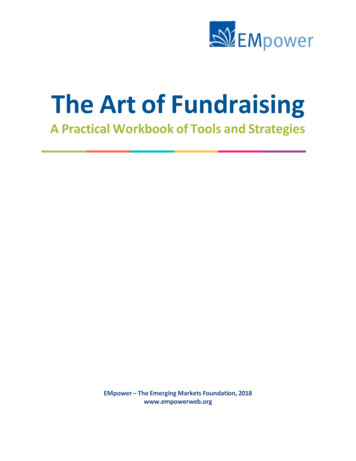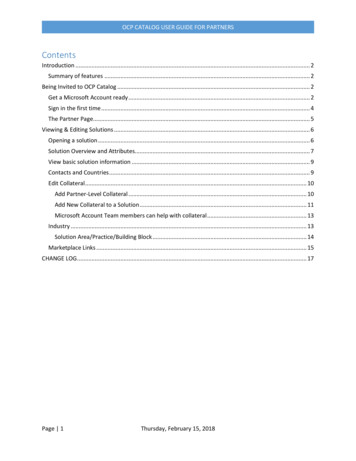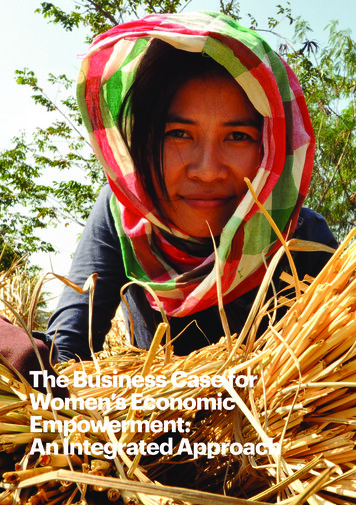
Transcription
The WHORegional Office for EuropeThe World Health Organization (WHO)is a specialized agency of the UnitedNations created in 1948 with the primaryresponsibility for international healthmatters and public health. The WHORegional Office for Europe is one of sixregional offices throughout the world,each with its own programme geared tothe particular health conditions of thecountries it serves.Member sBelgiumBosnia and HerzegovinaBulgariaCroatiaCyprusCzech groNetherlandsNorwayPolandPortugalRepublic of MoldovaRomaniaRussian FederationSan TajikistanThe former YugoslavRepublic of MacedoniaTurkeyTurkmenistanUkraineUnited KingdomUzbekistanEmpowerWomenFacing the Challenge of Tobacco Use in EuropeWorld Health Organization, Regional Office for EuropeUN City, Marmorvej 51, DK-2100 Copenhagen Ø, DenmarkTel.: 45 45 33 70 00. Fax: 45 45 33 70 01.E-mail: contact@euro.who.int. Web site: www.euro.who.int
EmpowerWomenFacing the Challenge of Tobacco Use in Europe
AbstractTen years have passed since the adoption of the WHO Framework Convention on Tobacco Control, a landmarkin tobacco control. Some of the WHO European Region Member States are global leaders in tobacco control.At the same time, the prevalence of smoking among women in the Region is higher than in any other WHOregion and, in some countries, is increasing among young women and girls. The tobacco industry continues towork relentlessly to catch new customers as early as possible in their lives, using well-targeted gender-specificstrategies. The report provides examples of effective tobacco-control action taken in Europe and elsewherethat may strengthen the hands of those interested in public health and tobacco control.KeywordsHEALTH POLICYSMOKINGTOBACCO INDUSTRYTOBACCO SMOKE POLLUTIONTOBACCO USE CESSATIONWOMENAddress requests about publications of the WHO Regional Office for Europe to:PublicationsWHO Regional Office for EuropeUN City, Marmorvej 51DK-2100 Copenhagen Ø, DenmarkAlternatively, complete an online request form for documentation, health information, or for permission to quote or translate,on the Regional Office web site (http://www.euro.who.int/pubrequest). World Health Organization 2015All rights reserved. The Regional Office for Europe of the World Health Organization welcomes requests for permission to reproduceor translate its publications, in part or in full.The designations employed and the presentation of the material in this publication do not imply the expression of any opinionwhatsoever on the part of the World Health Organization concerning the legal status of any country, territory, city or area or of itsauthorities, or concerning the delimitation of its frontiers or boundaries. Dotted lines on maps represent approximate border lines forwhich there may not yet be full agreement.The mention of specific companies or of certain manufacturers’ products does not imply that they are endorsed or recommendedby the World Health Organization in preference to others of a similar nature that are not mentioned. Errors and omissions excepted,the names of proprietary products are distinguished by initial capital letters.All reasonable precautions have been taken by the World Health Organization to verify the information contained in this publication.However, the published material is being distributed without warranty of any kind, either express or implied. The responsibility for theinterpretation and use of the material lies with the reader. In no event shall the World Health Organization be liable for damages arising from its use. The views expressed by authors, editors, or expert groups do not necessarily represent the decisions or the statedpolicy of the World Health Organization.Facing the Challenge of Tobacco Use in Europe
apter 1. Describing the problemPrevalence: who in the Region smokes?Health consequences of smoking in womenOverall tobacco-related mortalityDiseases caused by smokingSmoking and lung cancerSpecial case: smoking during pregnancyDiseases caused by exposure to second-hand smokeTobacco dependence in women223345666Chapter 2. New challenges for womenE-cigarettesPrevalence in EuropeRegulation of e-cigarettesHookah (water pipe, shisha, nargile, hubble-bubble)Snus77891010Chapter 3. Marketing by the tobacco and e-cigarette industriesMass-media advertisingCase study 1. Campaign targeting young girls (Germany)Case study 2. Campaign targeting young women and teenage girls (Switzerland)Case study 3. Outdoor advertising (Bulgaria)Marketing of e-cigarettesPack and product designDirect marketing to female consumersCase study 4. Music festivals (various countries)Corporate social responsibilityCase study 5. Projects of the tobacco industry on empowering women,youth and people with disabilities (Turkey)11121212131314151616Chapter 4. Response of the tobacco-control communityStopping the interference of the tobacco industry in health policy (WHO FCTC Article 5.3)Case study 6. Deadly marketing (Sweden)Protection from exposure to tobacco smoke (WHO FCTC Article 8)Case study 7. Smoke-free beaches in Gdansk (Poland)Case study 8. The REFRESH project: reducing families’ exposure to second-handsmoke in the home United Kingdom (Scotland)Product regulation (WHO FCTC Article 9 and 10)Case study 9. A ban on tobacco flavours (Canada)Labelling (WHO FCTC Article 11)Case study 10. Mass-media campaigns to reinforce the use of pictorial healthwarnings on packs (Russian Federation and Ukraine)Health education, communication, training and public awareness (WHO FCTC Article 12)Case study 11. The Cut Films project of the Deborah Hutton Campaign (United Kingdom)Advertising, promotion and sponsorship (WHO FCTC Article 13)Case study 12. The Norwegian ban on tobacco displaysTobacco-cessation services and support (WHO FCTC Article 14)Case study 13. Swedish national tobacco quitline: women’s alternative (Sweden)Stop-smoking services especially for womenCase study 14. Helping Catalonian women stop smoking er Womeniii
Brief, opportunistic adviceCase study 15. Counselling on smoking cessation delivered during screening forcervical cancer (Italy)iv3232Conclusions33References35Facing the Challenge of Tobacco Use in Europe
ForewordTen years have passed since the adoption of the WHO Framework Convention on Tobacco Control (WHOFCTC), a landmark in tobacco control. In this decade, much hard work has been carried out in the WHO European Region and globally to strengthen tobacco-control policies. Indeed, some of the countries of the Regionare global leaders in tobacco control. At the same time, however, the prevalence of smoking among women inthe Region is higher than in any other WHO region and, in some countries, is increasing among young womenand girls. This is an extremely serious concern. As we see men move out of the tobacco pandemic, we cannotcontemplate seeing women moving in. The smoking trends of women and men change over time and acrosspopulations as do gender norms and roles. This tendency has been clearly understood by the tobacco industry:it is now time for the health community to systematically intervene on the specific risks faced by women.Women are as likely as men to develop and die from the many diseases caused by smoking. In addition, theyface risks that are unique to their sex. Female smokers are now at as high a risk of dying from lung cancer as malesmokers. In some European countries we can see that the death rate for lung cancer in females has now overtaken that for breast cancer, hitherto the greatest killer of women among cancers. Even in countries where theprevalence rates of female smokers are far below those of male smokers, women and children are at great riskof contracting smoking-related diseases, such as asthma and cardiovascular disease, from breathing secondhand smoke.The Region’s ministers of health met in Turkmenistan in 2013 to discuss the global threat of noncommunicablediseases (NCDs) and how to address it. Tobacco is a common cause of the four major NCDs – cancer, cardiovascular disease, chronic respiratory disease and diabetes. The ministers of health agreed to work towardsachieving the global voluntary target of a 30% reduction of tobacco use by 2025, and shared the aspiration of atobacco-free Region. One of the first steps towards these ambitious goals is to ensure that tobacco-control policies are planned taking all the inhabitants of the Region into account. This means that policies must be planned,executed and monitored using a “gender lens”, and their likely impact considered equally for girls/women andboys/men. Monitoring and evaluation should target both sexes, and different age and socioeconomic groups.This report clearly shows that the tobacco industry continues to work relentlessly to catch new customers asearly as possible in their lives, using well-targeted gender-specific strategies. The European “women’s market” represents a glittering prize for the tobacco industry, and they will not stop trying to capture it unless theyare forced to do so. The report provides examples of effective tobacco-control action taken in Europe andelsewhere that may strengthen the hands of those interested in public health and tobacco control. This actioncomprises the creation of evidence-based policies that take women into account. We know that the WHOFCTC provides us with a legal framework for effective policy-making, and that sustained and comprehensiveefforts are needed to prevent the pain, disability and death caused by smoking. Acting together with strongand unremitting resolve, we can help the people of the European Region to live longer, healthier and happierlives. The European policy framework and strategy for the 21st century, Health 2020, recognizes that gendernorms and values influence behaviour and health-sector response. Using a gender approach whereby sex- andage-differentiated data are systematically taken into consideration, and the causes of inequality identified, is aprerequisite of any sound evidence-based policy aiming not only at improving the health of the population butalso at reducing gender-based inequality.Zsuzsanna Jakab,WHO Regional Director for EuropeEmpower Womenv
AcknowledgementsThe WHO Regional Office for Europe is grateful tothe many people who contributed to this publication.Special thanks are due to the three primary authorswho, as members of the International Network ofWomen Against Tobacco (INWAT), drew on its expertise: Margaretha Haglund, Expert in Tobacco Policy,Thinktank Tobaksfakta, Stockholm, Sweden; MartinaPötschke-Langer, Head, Unit of Cancer Preventionand WHO Collaborating Centre for Tobacco Control, Heidelberg, Germany; and Patti White, Analyst,National Institute for Health Care and Excellence(NICE), London, United Kingdom. We should also liketo highlight the contributions to the publication madeby the following team members of the WHO Collaborating Centre for Tobacco Control: Sarah Kahnert;Marcus Mau; Urmila Nair; Katrin Schaller; SusanneSchunk; and Sabine Vogel.Thanks go also to: Amanda Amos, Professor, HealthPromotion School, University of Edinburgh, Edinburgh, United Kingdom; Łukasz Balwicki, Lecturer,Public Health Specialist, Medical University, Gdansk,Poland; Göran Boethius, Chair, ThinkTank Tobaksfakta, Stockholm, Sweden; Magda Ciobanu, Coordinator of the Smoking Cessation Centre, Institute ofPneumology “Marius Nasta”, Bucharest, Romania;Elisabetta Chellini, Doctor of Epidemiology, Institutefor Study and Prevention of Cancer (ISPO), Florence,Italy; Norma Cronin, Smoking Cessation and TobaccoControl Consultant, Action on Smoking and Health(ASH) Ireland, Dublin, Ireland; Elif Dagli, Chair, HealthInstitute, Istanbul, Turkey; Pascal Diethelm, President,OxyRomandie, Geneva, Switzerland; Efza Evrengli,General Secretary, National Coalition on Tobacco orHealth, Health Institute, Istanbul, Turkey; Sibylle Fleitmann, Chair, Frauen Aktiv Contra Tabak e.V., Hannover, Germany; Gergana Geshanova, Chair, SmokeFree Life Coalition, Sofia, Bulgaria; Hans Giljam,viFacing the Challenge of Tobacco Use in EuropeProfessor Emeritus, Karolinska Institute, Stockholm,Sweden; Murat Guner, Marketing Director, HealthInstitute, Istanbul, Turkey; Mireia Jané, Deputy Director, Catalan Public Health Agency, Barcelona, Spain;Dietmar Jazbinsek, Sociologist/Journalist, DieterMennekes-Umweltstiftung, Kirchhundem, Germany;Dorata Kaleta, Public Health Expert, Preventive Medicine Department, MedicalUniversity, Łodz, Poland;Niels Them Kjaer, Project leader, Danish Cancer Society, Copenhagen, Denmark; Dominika Kozlowska,Public Relations Manager, Smoke Free Poland Partnership, Manko Association, Krakow, Poland; DariaKhaltourina, Board Chair, Center for Public Healthand Demography, Moscow, Russian Federation; IrinaMorozova, Communication Officer,World Lung Foundation, New York, USA; Isabel Nerin, Tobacco Cessation Expert, University School of Medicine, Zaragoza,Spain; Rebecca Perl, Associate Director, World LungFoundation, New York, USA; Charlotta H. Pisinger,Research Physician, Research Centre for Preventionand Health, Glostrup, Denmark; Ann Post, Manager,Swedish National Quitline, Centre for Epidemiologyand Community Medicine, Stockholm, Sweden; ElinRamfalk, General Secretary, Non Smoking Generation, Stockholm, Sweden; Jamilya Sadykova, NationalCoalition for a Smokefree Kazakhstan, Almaty, Kazakhstan; Sara Sanchez Bengtsson, Project Leader,Thinktank Tobaksfakta, Stockholm, Sweden; SeanSemple, Senior Lecturer, University of Aberdeen,United Kingdom; Dewi Segaar, Senior Adviser, Alliance Smokefree, The Hague, Netherlands; ElizabethTamang, Department of Prevention, Hygiene andPublic Health Service, Camposampiero, Italy; HelenaWilson, Senior Adviser, Ministry of Health and CareServices, Oslo, Norway; and Emma Wrafter, CharityDirector, The Deborah Hutton Campaign, London,United Kingdom.
IntroductionIn 2010, the WHO Regional Office for Europe published a report - prepared in collaboration with theInternational Network of Women Against Tobacco(INWAT) Europe - on the aggressive marketing oftobacco to women and young people in the European Region and the steps being taken to combatit (1). The WHO Framework Convention on TobaccoControl (WHO FCTC), the first international tobaccocontrol treaty, is a powerful instrument for use infighting against the strength and influence of thetobacco industry (2). The Convention strongly underpins gender equality, its preamble reminding us of theincrease in tobacco consumption among girls andwomen worldwide and the need for the participationof women at all levels of policy-making and implementation (2). Some of the strategies it recommends– for example, raising tobacco taxes, providing moreextensive protection from second-hand smoke, banning the promotion of tobacco products, removingpoint-of-sale display of tobacco, and mandating bigger graphic health warnings and plain or standardizedtobacco packaging – have been implemented both inEurope and in other parts of the world.The United Nations system, as a whole, has an influential position in the fight for better health and genderequality for all people of the world. The Convention onthe Elimination of All Forms of Discrimination againstWomen obliges Parties to take the appropriate measures to eliminate discrimination against women inhealth care (3). The Convention on the Rights of theChild obliges Parties to recognize children’s rights tothe highest attainable standard of health (4).In September 2011, the participants of the UnitedNations High Level Meeting on Non-CommunicableDiseases agreed to take unified action to combat thegrowing epidemic of these diseases (5). Contrary topopular belief, noncommunicable diseases (NCDs)pose a greater threat to low- and middle- incomecountries (LMICs) than they do to high-income countries. Currently, 80 % of annual deaths from NCDs –equivalent to 29 million people – occur in LMICs andthis percentage is projected to increase (6). Tobaccoconsumption is a risk factor common to the leadingNCDs. In the Ashgabat Declaration (7), WHO European Member States confirmed their commitmentto accelerating efforts to achieve full implementationof WHO FCTC, to reach the global target for NCDsrelated to tobacco use (30% relative reduction by2025), and shared their ambition of working towardsa tobacco-free European Region.In addition to the obvious humanitarian reasons tocurb NCDs, the current financial crisis gives a cleareconomic incentive to do so. The annual economicloss per person as a result of inactivity caused byNCDs is estimated to be US 25 in low-income countries, US 50 in middle-income countries and US 140 in high-income countries. The financial crisis hasnot affected women and men equally and, therefore,while the impact of population-based and individualbased intervention may reduce overall prevalence, itcould also increase the inequity gap if gender assessment across socioeconomic groups is not included in“best buy” initiatives.It is essential to remember that tobacco is the onlyconsumer product in the world that kills about half ofits customers when used as the manufacturers intended. There is still a large imbalance between whatcan be done by those interested in promoting publichealth and the power of the tobacco industry andits allies (tobacco growers, advertising and publicrelations bodies, distribution networks, front groupsand covertly funded “think tanks”, among others) tocontinue to evade the rules and government efforts toeliminate excessive hazards to health.Empower Women1
Chapter 1.Describing the problemBased on the latest data in the WHO report on theglobal tobacco epidemic, 2013: enforcing bans ontobacco advertising, promotion and sponsorship (8),roughly 28% of adults in the WHO European Regionsmoke tobacco in contrast to 20% of adults in theRegion for the Americas and 15% of adults in theAfrican Region. Currently, the European Region hasthe highest prevalence of female smokers (19%) ofall WHO regions. Much progress has been madesince the WHO FCTC came into force in 2005, when35.3% of adults (44.9% males and 25% females) inthe European Region smoked tobacco, and there isgreat potential to advance much further by fully implementing the WHO FCTC, using a gender approach.The overall pattern of smoking across Europe reflectsthe spread of the smoking epidemic: men in westernand northern European countries took up smokingfirst and women in these countries followed suit; thesame development then occurred in the countries ofsouthern and central Europe (9).Prevalence: who in the Regionsmokes?The countries can be grouped according to thestage of the smoking epidemic they are at, reflectinglocal smoking patterns for females and males. In theNordic and some other western European countries,there is little or no difference between the smokingrates for females and males, for example, in Denmark(2012) with 24% and 24.7%, respectively (10), Ireland(2012) with 20.0% and 22.6%, respectively (11), andthe United Kingdom (2012) with 20% and 21%, respectively (12). Although in many countries of centraland southern Europe more men than women smoke,in some, the rates for female smokers are high andstill increasing. Austria, Bulgaria, the Czech Republicand Greece fall into this group; they also have thehighest prevalence rates of smoking in adult femalesrecorded in the Region, namely, 34.7%, 28.2%,32.3% and 38%, respectively (Fig. 1) (13). Finally, athird group of countries, notably those of the formerFig. 1. Prevalence of tobacco smoking, females 15 years, WHO European Region, 2009 10.0 %10.1-15.0 %15.1-30 %30.1-45 % 45 %Not applicableNo dataNote. The graphics are based on data originating from Tobacco control country profiles, 2009 (13).Sources: WHO report on the global tobacco epidemic, 2013: enforcing bans on tobacco advertising, promotion and sponsorship (8); Tobacco controlcountry profiles, 2009 (13); Prevalence of tobacco use among adults and adolescents [website], 2012 (14).2Facing the Challenge of Tobacco Use in Europe
Table 1. Prevalence of tobacco use among adults (2011) and adolescents (2008-2012), selectedcountriesCountryAdults (15 years)2011Adolescents (13-15 .6Croatia363026.727.0Czech 21.623.9Italy311819.421.6Latvia462029.233.8Source: Global Youth Tobacco Survey, 2013 (18).Soviet Union, have high rates of smoking among menand relatively low but increasing rates among women.There are numerous reasons for the smoking trendsobserved among European women and girls.Although this report will focus on the tremendousimpact of tailored marketing by the tobacco industrythrough well-funded campaigns, it is important toconsider several other factors. In general, smokingamong females is highly influenced by socioeconomic status, the most affluent often being both thefirst to start and the first to quit. The countries wheresmoking is increasingly associated with low socioeconomic status are also among those with the longesthistories of smoking. The highest rates of smokingare found among the unemployed, the self-employedand manual workers (15). Smokers in lower socioeconomic groups commonly start at a younger agethan those with higher socioeconomic status, theirdaily consumption is larger, they are at greater risk ofbecoming addicted, and they find it much more difficult to quit (16). Finally, girls and young women withlower socioeconomic status are largely unaware ofthe health risks of smoking and second-hand smokeand, therefore, are vulnerable to the advertising strategies of the tobacco industry. The addictive nature oftobacco consumption is often underestimated (17).The results of the Global Youth Tobacco Survey(GYTS) carried out in 2013 (18) reveal that, in severalcountries, although the prevalence of smoking inadult men is higher than in adult women, the reverseis seen among adolescents (13–15 years) (Table 1).In other countries, the prevalence gap between boysand girls is very small or on the verge of closing, andthe increasing rate of tobacco use in females is ofgreater concern.Another prevailing issue is that social and culturalconstraints are changing in the majority of the coun-tries of the Region, and it has become more acceptable for females to use tobacco. Smoking is oftenportrayed by the tobacco industry as a symbol ofempowerment, emancipation and success. Cigarettepacks resembling lipstick cases, for example, spreadthe sense of being associated with glamour and fashion (19). Women’s spending power has increased andcigarettes are becoming more affordable for them,especially in countries where tobacco taxes havenot been raised. The impact of the tobacco industry’s marketing strategy is of indisputable magnitude(20,21).A side effect of the smoking trends in Europe is thehigh number of women and children that are exposedto second-hand smoke, especially in the southernand eastern parts of the Region (Fig. 2) (22).Health consequences ofsmoking in womenOverall tobacco-related mortalityA recent study of one million women in the UnitedKingdom showed that smoking remains the leadingpreventable cause of death in women. Smokers loseat least ten years of their lives, but if they stop beforethe age of 30, 97% of the excess mortality caused bycontinued smoking can be avoided; if they stop wellbefore the age of 40, more than 90% can be avoided(Fig. 3). On the other hand, continuing to smoke afterthe age of 40 will result in a 10-fold increase in thehazards it causes. Even in the case of women whosmoked fewer than ten cigarettes per day (baseline),12-year mortality was doubled. The risk of contracting 23 of the 30 most common causes of death alsoincreased significantly in smokers: for lung cancer,the rate ratio was 21.4. Among ex-smokers who hadstopped permanently at ages 25–34 years or 35–44years, the respective relative risks were 1.84 and 3.34for lung-cancer mortality (23).Empower Women3
Fig. 2. Prevalence of female exposure to second-hand smoke in the WHO European Region, 2010 10.0 %10.1-15.0 %15.1-30 %30.1-45 % 45 %Source: Global estimate of the burden of disease from second-hand smoke, 2011 (22).Fig. 3. All-cause mortality: illustration of the effects of a 3-fold difference in annual death rates ofwomen on mortality from 35 to 80 years, United KingdomSource: reprinted with permission from Elsevier (The Lancet. 2013; 381(9861):133-41) (23).Diseases caused by smokingIt is well documented that women are just as vulnerable as men to the dangers of tobacco, if notmore so. Tobacco smoke is a mixture of about 4800compounds containing 90 known carcinogens andabout 250 toxic substances (24-26). Smoking hasa harmful effect on nearly every organ of the body,as well as on general health. It is the cause of manydiseases and is a significant risk factor for severalsevere chronic diseases, such as different types of4Facing the Challenge of Tobacco Use in Europecancer, cardiovascular and respiratory diseases, anddiabetes mellitus (Fig. 4). Female smokers have thesame risk of stroke as men, but they also reap similarbenefits as men in avoiding cardiovascular diseasesif they stop smoking (27). Smoking also harms theeyes, teeth and bone structure and reduces fertility(28). There is also strong evidence of an associationbetween tobacco and tuberculosis: smoking reduceshost defence in the lung and increases the risk ofinfection by a factor of more than two and a half. In
Fig. 4. Smoking-related diseasesEyes ()LungOral cavityNaso-, oro- and hypopharynxNasal cavity and paranasl verKidney (body and pelvis)UreterUrinary bladderBone marrowRespiratory Diseases ()Teeth (CataractAge-relatedmacula degenerationCardiovascular Diseases (Metabolic Disorders ())Diabetes mellitusInsulin resistanceWomen ())Infertility/SubfertilityComplications in pregnancy(placenta preavia, placental abruption,premature rupture of membranes,pre-term birth, intrauterine growth restrictions,spontaneous abortion, and stillbirth))Osteoporosis (post-menopausal)Cancer of uterine cervixCancer of the ovary (mucinous)Breast cancerImpotenceNew-born infants (PeriodontitisCariesAtherosclerosisMyocardial InfarctionCerebrovasular disease(ischaemic stroke)Abdominal aortic aneurysmsCoronary heart disease (CHD)Chronic obstructivepulmonary disease (COPD)Pulmonary emphysemaChronic bronchitisAsthmaMen ())Children (Reduced birth weightReduced birth lengthLow head circumferenceGrowth impairmentCleft lip and palateSudden infant death syndrome (SIDS))HepatoblastomaChildhood leukemia (in particularacute lymphocytic leukemia)Childhood obesity German Cancer Research CenterCancer (Source: reproduced with permission by the German Cancer Research Center (31).fact, more than 20% of global tuberculosis incidenceis attributable to smoking (29). Smoking may impairimmunologic defence in the airways and promote thelikelihood of infectious disease; more specifically, itmay strengthen the aggressiveness of microbes andtheir resistance to antibiotic treatment (30).Smoking and lung cancerLung cancer is an ever-increasing health problem forEuropean women (32). For example, between 1990and 2004, the numbers of new cases of lung cancerin female smokers in Germany more than doubled(33). While trends for most cancers may show a levelling off or even a decline throughout Europe, this isnot the case for lung cancer in women. It is expectedthat lung cancer will become the primary cause ofcancer death in European women within a few years,overtaking breast cancer (32). This is already the casein a number of countries of the Region, for example,Albania, Denmark, Hungary, Ireland, Luxembourg,the Netherlands, Norway, Poland, Sweden, Switzerland and the United Kingdom (34). While in Poland,for example, the rates of lung cancer in women havebeen increasing steadily, in the United Kingdom theyincreased until the late 1980s and then began todecline, continuing to do so until the early 2000s;however, after the year 2000, they started to increaseagain. Lung-cancer rates increase with a delay ofabout ten to twenty years after increased smokingprevalence (35).Special case: smoking during pregnancySmoking also compromises pregnancy and reproductive health. The prevalence of smoking in pregnantEmpower Women5
women is strongly related to age and socioeconomicstatus. In the Nordic countries, the highest rates ofsmoking during early pregnancy are observed amongteenagers (24% in Sweden and 49% in Finland andNorway). Moreover, single pregnant women are 2-3times more likely to smoke than married pregnantwomen and those in the lowest socioeconomicgroups are 6-7 times more likely to smoke duringearly pregnancy than those with a higher socioeconomic status (36). Similar trends of smoking in earlypregnancy have also been observed in Spain, wherethe most vulnerable groups are manual workers andwomen with low levels of education (37).Babies of women who smoke have a higher risk ofbeing born with low birth weight than do those ofnon-smokers. Women who smoke during pregnancyhave a high risk of severe complications, includingmiscarriage, stillbirth and serious malformations ofthe unborn child, such as musculoskeletal defects,limb reduction, missing/extra digits or facial defects(38,39), congenital heart defects (septal defects) andcleft palate, as well as sudden infant death syndromeand childhood obesity (28,40,41).Diseases caused by exposure to second-handsmokeExposure to second-hand smoke is a big issue forwomen everywhere, but especially in some of thesouthern and eastern European countries wheremany men smoke. Breathing second-hand
Case study 2. Campaign targeting young women and teenage girls (Switzerland) 12 Case study 3. Outdoor advertising (Bulgaria) 13 Marketing of e-cigarettes 13 Pack and product design 14 Direct marketing to female consumers 15 Case study 4. Music festivals (various countries) 16 Corporate social responsibility 16 Case study 5.










